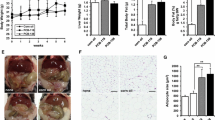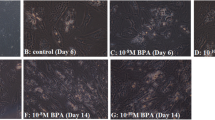Abstract
Phthalates are lipophilic and tend to accumulate in adipose tissue, an important regulator of energy balance and glucose homeostasis. The study aimed to determine whether cellular phthalate accumulation influenced fat cell energy metabolism. Following a 3-day treatment with adipogenesis-inducing medium and a 2-day treatment with adipogenesis-maintaining medium, 3T3-L1 cells differentiated into adipocytes in the presence of a phthalate at a clinically relevant concentration (30–300 μM) for another 6 days. Two phthalates, di(2-ethylhexyl)phthalate and di-n-butylphthalate, and their metabolites, mono(2-ethylhexyl)phthalate (MEHP) and mono-n-butylphthalate, were used here. The phthalate treatments caused no marked effect on cytotoxicity and adipogenesis. Only the MEHP-treated adipocytes were found having smaller lipid droplets; MEHP accumulated in cells in a dose- and time-dependent manner. The MEHP-treated adipocytes exhibited significant increases in lipolysis and glucose uptake; quantitative real-time polymerase chain reaction (qPCR) analysis revealed correlated changes in expression of marker genes involved in adipogenesis, lipid metabolism, and glucose uptake. Analysis of oxygen consumption rate (a mitochondrial respiration indicator) and extracellular acidification rate (a glycolysis indicator) indicated a higher energy metabolism in the adipocytes. qPCR analysis of critical genes involved in mitochondrial biogenesis and/or energy metabolism showed that expression of peroxisome proliferator-activated receptor γ coactivator-1α, sirtuin 3, and protein kinase A were significantly enhanced in the MEHP-treated adipocytes. In vitro evidence of MEHP impacts on lipolysis, glucose uptake/glycolysis, and mitochondrial respiration/biogenesis demonstrates that MEHP accumulation disturbs energy metabolism of fat cells.




Similar content being viewed by others
References
ATSDR (Agency for Toxic Substances and Disease Registry) (2002) Toxicological profile for di(2-ethylhexyl)phthalate. Atlanta, GA
Becker K, Goen T, Seiwert M et al (2009) GerES IV: phthalate metabolites and bisphenol A in urine of German children. Int J Hyg Environ Health 212(6):685–692. doi:10.1016/j.ijheh.2009.08.002
Brenmoehl J, Hoeflich A (2013) Dual control of mitochondrial biogenesis by sirtuin 1 and sirtuin 3. Mitochondrion 13(6):755–761. doi:10.1016/j.mito.2013.04.002
Campioli E, Batarseh A, Li J, Papadopoulos V (2011) The endocrine disruptor mono-(2-ethylhexyl) phthalate affects the differentiation of human liposarcoma cells (SW 872). PLoS ONE 6(12):e28750. doi:10.1371/journal.pone.0028750
Cao H, Sekiya M, Ertunc ME et al (2013) Adipocyte lipid chaperone AP2 is a secreted adipokine regulating hepatic glucose production. Cell Metab 17(5):768–778. doi:10.1016/j.cmet.2013.04.012
Ducluzeau PH, Fletcher LM, Vidal H, Laville M, Tavare JM (2002) Molecular mechanisms of insulin-stimulated glucose uptake in adipocytes. Diabetes Metab 28(2):85–92
Durmaz E, Ozmert EN, Erkekoglu P et al (2010) Plasma phthalate levels in pubertal gynecomastia. Pediatrics 125(1):e122–e129. doi:10.1542/peds.2009-0724
Ellero-Simatos S, Claus SP, Benelli C et al (2011) Combined transcriptomic-(1)H NMR metabonomic study reveals that monoethylhexyl phthalate stimulates adipogenesis and glyceroneogenesis in human adipocytes. J Proteome Res 10(12):5493–5502. doi:10.1021/pr200765v
Fasshauer M, Klein J, Ueki K et al (2000) Essential role of insulin receptor substrate-2 in insulin stimulation of Glut4 translocation and glucose uptake in brown adipocytes. J Biol Chem 275(33):25494–25501. doi:10.1074/jbc.M004046200
FDA (Food and Drug Administration) (2001) Safety assessment of di(2-ethylhexyl)phthalate (DEHP) released from PVC medical devices. Rockville
Feige JN, Gelman L, Rossi D et al (2007) The endocrine disruptor monoethyl-hexyl-phthalate is a selective peroxisome proliferator-activated receptor gamma modulator that promotes adipogenesis. J Biol Chem 282(26):19152–19166
Feige JN, Gerber A, Casals-Casas C et al (2010) The pollutant diethylhexyl phthalate regulates hepatic energy metabolism via species-specific PPARalpha-dependent mechanisms. Environ Health Perspect 118(2):234–241. doi:10.1289/ehp.0901217
Gerhart-Hines Z, Dominy JE Jr, Blattler SM et al (2011) The cAMP/PKA pathway rapidly activates SIRT1 to promote fatty acid oxidation independently of changes in NAD(+). Mol Cell 44(6):851–863. doi:10.1016/j.molcel.2011.12.005
Grahn TH, Kaur R, Yin J et al (2014) Fat-specific protein 27 (FSP27) interacts with adipose triglyceride lipase (ATGL) to regulate lipolysis and insulin sensitivity in human adipocytes. J Biol Chem 289(17):12029–12039. doi:10.1074/jbc.M113.539890
Greenberg AS, Coleman RA, Kraemer FB et al (2011) The role of lipid droplets in metabolic disease in rodents and humans. J Clin Investig 121(6):2102–2110. doi:10.1172/JCI46069
Hao C, Cheng X, Guo J, Xia H, Ma X (2013) Perinatal exposure to diethyl-hexyl-phthalate induces obesity in mice. Frontiers in bioscience 5:725–733
Hsu HF, Tsou TC, Chao HR, Kuo YT, Tsai FY, Yeh SC (2010a) Effects of 2,3,7,8-tetrachlorodibenzo-p-dioxin on adipogenic differentiation and insulin-induced glucose uptake in 3T3-L1 cells. J Hazard Mater 182(1–3):649–655. doi:10.1016/j.jhazmat.2010.06.081
Hsu HF, Tsou TC, Chao HR et al (2010b) Effects of arecoline on adipogenesis, lipolysis, and glucose uptake of adipocytes-A possible role of betel-quid chewing in metabolic syndrome. Toxicol Appl Pharmacol 245(3):370–377. doi:10.1016/j.taap.2010.04.008
Kajimura S, Seale P, Spiegelman BM (2010) Transcriptional control of brown fat development. Cell Metab 11(4):257–262. doi:10.1016/j.cmet.2010.03.005
Koch HM, Christensen KL, Harth V, Lorber M, Bruning T (2012) Di-n-butyl phthalate (DnBP) and diisobutyl phthalate (DiBP) metabolism in a human volunteer after single oral doses. Arch Toxicol 86(12):1829–1839. doi:10.1007/s00204-012-0908-1
Lass A, Zimmermann R, Oberer M, Zechner R (2011) Lipolysis—a highly regulated multi-enzyme complex mediates the catabolism of cellular fat stores. Prog Lipid Res 50(1):14–27. doi:10.1016/j.plipres.2010.10.004
Lind PM, Roos V, Ronn M et al (2012) Serum concentrations of phthalate metabolites are related to abdominal fat distribution two years later in elderly women. Environ Health Global Access Sci Source 11:21. doi:10.1186/1476-069X-11-21
Miki H, Yamauchi T, Suzuki R et al (2001) Essential role of insulin receptor substrate 1 (IRS-1) and IRS-2 in adipocyte differentiation. Mol Cell Biol 21(7):2521–2532. doi:10.1128/MCB.21.7.2521-2532.2001
Miura Y, Naito M, Ablake M et al (2007) Short-term effects of di-(2-ethylhexyl) phthalate on testes, liver, kidneys and pancreas in mice. Asian J Androl 9(2):199–205. doi:10.1111/j.1745-7262.2007.00220.x
Miyoshi H, Perfield JW 2nd, Souza SC et al (2007) Control of adipose triglyceride lipase action by serine 517 of perilipin A globally regulates protein kinase A-stimulated lipolysis in adipocytes. J Biol Chem 282(2):996–1002. doi:10.1074/jbc.M605770200
Miyoshi H, Perfield JW 2nd, Obin MS, Greenberg AS (2008) Adipose triglyceride lipase regulates basal lipolysis and lipid droplet size in adipocytes. J Cell Biochem 105(6):1430–1436. doi:10.1002/jcb.21964
Mori T, Sakaue H, Iguchi H et al (2005) Role of Kruppel-like factor 15 (KLF15) in transcriptional regulation of adipogenesis. J Biol Chem 280(13):12867–12875. doi:10.1074/jbc.M410515200
Ntambi JM, Young-Cheul K (2000) Adipocyte differentiation and gene expression. J Nutr 130(12):3122S–3126S
Nurjhan N, Consoli A, Gerich J (1992) Increased lipolysis and its consequences on gluconeogenesis in non-insulin-dependent diabetes mellitus. J Clin Investig 89(1):169–175. doi:10.1172/JCI115558
Park BO, Ahrends R, Teruel MN (2012) Consecutive positive feedback loops create a bistable switch that controls preadipocyte-to-adipocyte conversion. Cell Rep 2(4):976–990. doi:10.1016/j.celrep.2012.08.038
Posnack NG, Swift LM, Kay MW, Lee NH, Sarvazyan N (2012) Phthalate exposure changes the metabolic profile of cardiac muscle cells. Environ Health Perspect 120(9):1243–1251. doi:10.1289/ehp.1205056
Prosdocimo DA, Anand P, Liao X et al (2014) Kruppel-like factor 15 is a critical regulator of cardiac lipid metabolism. J Biol Chem 289(9):5914–5924. doi:10.1074/jbc.M113.531384
Pulido MR, Diaz-Ruiz A, Jimenez-Gomez Y et al (2011) Rab18 dynamics in adipocytes in relation to lipogenesis, lipolysis and obesity. PLoS ONE 6(7):e22931. doi:10.1371/journal.pone.0022931
Rhind SM, Kyle CE, Telfer G, Duff EI, Smith A (2005) Alkyl phenols and diethylhexyl phthalate in tissues of sheep grazing pastures fertilized with sewage sludge or inorganic fertilizer. Environ Health Perspect 113(4):447–453
Rosen ED, Spiegelman BM (2000) Molecular regulation of adipogenesis. Annu Rev Cell Dev Biol 16:145–171. doi:10.1146/annurev.cellbio.16.1.145
Rosen ED, Spiegelman BM (2006) Adipocytes as regulators of energy balance and glucose homeostasis. Nature 444(7121):847–853. doi:10.1038/nature05483
Rozo AV, Vijayvargia R, Weiss HR, Ruan H (2008) Silencing Jnk1 and Jnk2 accelerates basal lipolysis and promotes fatty acid re-esterification in mouse adipocytes. Diabetologia 51(8):1493–1504. doi:10.1007/s00125-008-1036-6
Shelby MD (2006) NTP-CERHR monograph on the potential human reproductive and developmental effects of di (2-ethylhexyl) phthalate (DEHP). Ntp Cerhr Mon 18:v, vii-7, II–iii–xiii passim
Stahlhut RW, van Wijngaarden E, Dye TD, Cook S, Swan SH (2007) Concentrations of urinary phthalate metabolites are associated with increased waist circumference and insulin resistance in adult U.S. males. Environ Health Perspect 115(6):876–882. doi:10.1289/ehp.9882
Su PH, Chang YZ, Chang HP et al (2012) Exposure to di(2-ethylhexyl) phthalate in premature neonates in a neonatal intensive care unit in Taiwan. Pediatr Crit Care Med J Soc Crit Care Med World Fed Pediatr Intensive Crit Care Soc 13(6):671–677. doi:10.1097/PCC.0b013e3182455558
Weuve J, Sanchez BN, Calafat AM et al (2006) Exposure to phthalates in neonatal intensive care unit infants: urinary concentrations of monoesters and oxidative metabolites. Environ Health Perspect 114(9):1424–1431
Wilson-Fritch L, Nicoloro S, Chouinard M et al (2004) Mitochondrial remodeling in adipose tissue associated with obesity and treatment with rosiglitazone. J Clin Investig 114(9):1281–1289. doi:10.1172/JCI21752
Zeng Q, Wei C, Wu Y et al (2013) Approach to distribution and accumulation of dibutyl phthalate in rats by immunoassay. Food Chem Toxicol Int J Publ Br Ind Biol Res Assoc 56:18–27. doi:10.1016/j.fct.2013.01.045
Zhang YH, Chen BH, Zheng LX, Wu XY (2003) Study on the level of phthalates in human biological samples. Zhonghua yu fang yi xue za zhi [Chin J Prevent Med] 37(6):429–434
Acknowledgments
We thank Ms. Chien-Wen Sun for analysis of MEHP and its metabolites. This work was supported by grants from the Ministry of Science and Technology (101-2314-B-400-003-MY3, 102-2811-B-400-015, and 103-2811-B-400-022 to T.C.T.) and the National Health Research Institutes (EO-102-PP-03 and EO-103-PP-03 to T.C.T.; EH-102-SP02 and EH-103-SP02 to S.L.W.) in Taiwan.
Author information
Authors and Affiliations
Corresponding author
Electronic supplementary material
Below is the link to the electronic supplementary material.
Rights and permissions
About this article
Cite this article
Chiang, Hc., Kuo, YT., Shen, CC. et al. Mono(2-ethylhexyl)phthalate accumulation disturbs energy metabolism of fat cells. Arch Toxicol 90, 589–601 (2016). https://doi.org/10.1007/s00204-014-1446-9
Received:
Accepted:
Published:
Issue Date:
DOI: https://doi.org/10.1007/s00204-014-1446-9




